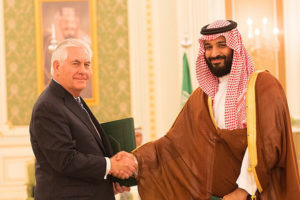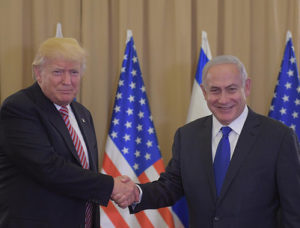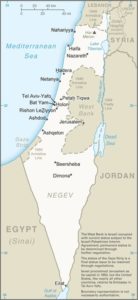President Trump’s first trip overseas started off spectacularly. The United States Secretary of State held a press briefing with the Foreign Minister of Saudi Arabia outlining the accomplishments of day one.

U.S. Secretary of State with Saudi Deputy Crown Prince
According to Yahoo News in its piece titled, Saudi King confident Trump can solve Israeli–Palestinian conflict, Foreign Minister says, the foreign minister stated,
“He certainly has the vision and we believe the strength and the decisiveness,” … “And the Kingdom of Saudi Arabia stands prepared to work with the United States in order to bring about peace between Israelis and Palestinians, and Israelis and Arabs.”
The video of the full press briefing is available here.
Newsweek published President Trump’s daily schedule on its website for the 8 day trip here.
Leg Two

U.S. President with Israel’s Prime Minister
His next stop in Israel on Monday May 22nd and on Tuesday May 23rd coincided with the first two days of the 50thanniversary of the 1967 Six-Day War on the Hebrew calendar.
Israel defeated her Arab neighbors in that conflict. In the process, she took the Sinai Peninsula, Golan Heights, Gaza Strip, the West Bank and the rest of the previously divided Jerusalem.
News video aired of the president praying at the Western Wall. The president of Russia did the same in 2012. We previously covered that in a related article with the title, “December 15, 2016 – A Capital Question”.
On May 23rd President Trump met with Palestinian Authority President Mahmoud Abbas. ABC News and DW News reported the president is convinced that both the Palestinians and Israelis are “ready to reach for peace”.
Wednesday May 24th is the national Israeli holiday called Jerusalem Day. According to the Hebrew calendar, this is the date Israel captured the Western Wall and Temple Mount in old Jerusalem. On the 24th, however, President Trump was in Rome meeting with the head of the Roman Catholic Church.
The mere fact President Trump chose to visit the region first greatly pleased Arabs and Israelis. And his visit to Jerusalem’s Western Wall was a first for an American president.
The Times of Israel newspaper wrote on May 15, 2017,
“As candidates, many US politicians stop by the Jerusalem holy site, but once in the White House they’ve all stayed away”.
US Embassy Issue
In his Op Ed for Israel’s Ynet News, Kobi Richter remarked,

“Trump has a way of keeping his promise without binding himself to what Bennett and Netanyahu are trying to impose on him. Moving the embassy to Jerusalem—yes; Jerusalem as Israel’s capital—yes; a united Jerusalem—no. Trump’s escape, with the lack of any other offer that the Palestinians can accept, is a US embassy for Israel in west Jerusalem and a US embassy for Palestine in east Jerusalem.”
The Palestinian birthrate has continued to outstrip the Jewish Israeli population growth over the decades. Acknowledging this reality, Richter added,
“When at least 40 percent of the people who have the right to vote in the municipal elections are Palestinian, a failure to return to a Jewish Jerusalem will lead to a situation in which the election of an Arab mayor in Jerusalem depends only on the Palestinians’ ability to bring their voters to the polling stations.”
People wonder if Richter’s view might be a clue to what President Trump proposed to other leaders visited in May of 2017 or whether he and his team had something entirely different in mind to get the Israeli–Palestinian peace negotiations restarted.
Peace Prospects
If, or when, the two long time antagonists get back to the table, will the following gain enough traction to be part of a mutually agreed peace accord?
- West Jerusalem, 50 years later, officially recognized as Israel’s capital
- East Jerusalem transferred to the Palestinians and available to be their capital as part of a much talked about two state solution
- Temple Mount area given special status somewhat like Washington DC, which is not the part of any state in America
- The Temple Mount area under some interfaith or international control superseding the present Islamic Waqf supervision
- Establishment of an interfaith complex on the Temple Mount open to all — likely incorporating one of the two mosques currently on the mount, plus a location for Sunday worshipers, as well as a third spot for Jews
Iran, not likely to wholeheartedly embrace such an agreement, might be unable to stop the process at this point. And the Palestinians might be persuaded, by their other Arab neighbors that, as the saying goes, a half a loaf is better than none — for now. But can we expect long-term peace between them and throughout the region to result from this? No.
Photo credits: U.S. Secretary of State Rex Tillerson with Deputy Crown Prince Mohammad bin Salman Al Saud, Official White House Photo by Shealah Craighead, License: CC BY 2.0; President Trump with Prime Minister Netanyahu, courtesy of Israel Ministry of Foreign Affairs by Amos Ben Gershom GPO, License: CC BY-NC 2.0; Map courtesy of CIA.